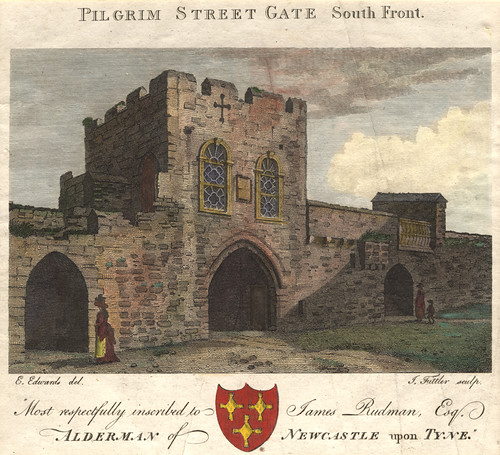
Newcastle
Pilgrim Street Gate
Last Updated:
5 Nov 2024
Newcastle
This is a
Gate, Town Defences
54.974255, -1.611789
Founded in
Current status is
Demolished
Designer (if known):

Now on the Blackett Street junction
This is an instantly recognisable Newcastle vista, and you can probably hear the clattering of construction just by looking at it. The junction was once the main gateway into the town from the Great North Road - the Pilgrim Gate.
It was the cornerstone of the city defences - the lifeline between sanctuary and fraught danger. In fact, it was certainly fired at during the siege of 1644 as a 24lb cannonball was found in the wall during demolition. Pilgrim Street is one of the oldest streets in Newcastle, so named potentially for the pilgrims passing up to the holy areas of Northumberland or St Mary's at Jesmond, but given so there's every chance it was the earliest surviving gate in the city too.
It was certainly here in 1280 - a crenelated tower across two stories and was very low. By the end wagons apparently had to be removed of their goods to pass through. Mackenzie notes it was "strong", but "clumsy and gloomy" further reiterating its age.
Though it was repaired and dressed up by the Joiners Company in 1716 (who inhabited it for a while), it was still a pain for a city squeezing out of its historic boundaries. Foot passages were opened each side which can be seen on the illustrations below, but was still rendered to be holding back the town. After a long and successful history fortifying the town from northern raiders, it was demolished in 1802 - finally opening up the city and aiding Northumberland Street to be the lynchpin of Newcastle's success. Carts and wagons could finally pass with ease (though still had to make it up the hill!) and traffic could flow freer.
Listing Description (if available)


Both plans depicted here illustrate the Pilgrim Gate between the 1720s and 1760s. You'll notice the town was still quite dense, albeit largely consistent through the 18th century. Anderson Place sits directly underneath the gate, which was between Fickett Tower (next to Greys Monument) and Carliol Tower (at John Dobson Street). Some of the buildings on Pilgrim Street still remain, notably Alderman Fenwicks House and 70 Pilgrim Street, now the Market Lane pub.
Northumberland Street, outside the town defences, was just growing by the 1720s. Large scale development was still fraught given the siege was less than a century prior, however decades of safety eventually led to the degradation and demolition of the town walls.

The turn of the 19th century saw the Pilgrim Gate demolished, opening up the city and allowing it to become what it is today. There is no trace of the defence at this stage - only the Carliol & Plummer Tower's this side of the city.

The site of the Pilgrim Gate in September 2024

Anderson Place in the 1700s, copper engraving by Pieter van der Aa. A fairly dramatised Pilgrim Gate can be seen on the right. You can really feel the depression of development outside the walls, and only in the comin decades would it transition from peripheral agricultural land and modest houses to what we see today.

The south front of the Pilgrim Gate in 1786. The footways are extant by this stage, though the walls are degrading. Source: Newcastle Libraries
